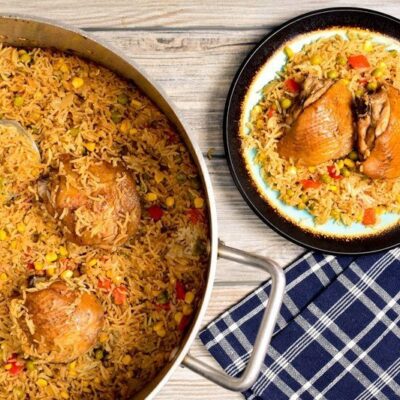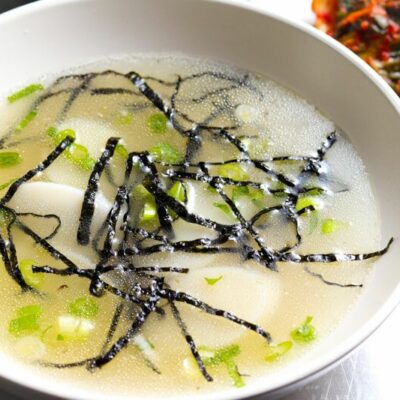
Rice is one of the most classic ingredients and features in cuisines throughout the world, including many Japanese and Chinese meals. Its popularity is easy to understand, as rice is inexpensive, versatile, and surprisingly filling. It can be served on its own as a side dish or included as part of a more complex dish, like rice pilaf or rice balls.
Beyond this, the mild flavor of rice allows other ingredients to truly shine. This is why you see rice used in so many different dishes and with so many ingredient combinations. Rice also works well as a side for many dishes, like salmon and even chili (yes, really, chili and rice is a thing).
Still, despite its usefulness, rice isn’t always the right choice. Sometimes you’ll want an ingredient that’s lower in carbs. Other times, you might want one with more nutrients or a different flavor. Thankfully, there are plenty of substitutes for rice, including quinoa, couscous, cauliflower rice, chopped cabbage, and more.
Some of these substitutes will be familiar, as they’re frequently used instead of rice. Others are less common but have their own stunning features. The best for your situation will depend on your preferences and how you plan to use the ingredient. Are you serving it as a side or as part of a dish? Are you looking for a starchy side? Do you want it to taste like white rice?
Substitutes For Rice
Cauliflower Rice

Cauliflower rice must be the most famous modern rice substitute. It is simply made by chopping cauliflower florets and then blitzing them in the food processor. Then, you simply need to remove any excess liquid. This is often done by squeezing the ‘rice’ in an absorbent cloth or paper towel.
Once it’s been prepared, cauliflower can be used raw or cooked in most of the same meals as rice. It can even be stir-fried, in which case, the rice will take on flavors from other ingredients.
If you don’t want to make it, no worries. Cauliflower rice has become popular enough that you can find it in many stores.
The rice alternative even has advantages over regular rice, as it is lower in carbs and calories, making it excellent for weight loss and for low carb dieters. The nutrient content is decent as well, making cauliflower rice even more appealing.
That said, cauliflower rice doesn’t have the same flavor and texture as regular rice. It tends to be grainier, with a vegetable-like flavor. Cauliflower rice also lacks the chewiness found with regular rice. Still, no rice replacement will mimic rice precisely.
Quinoa

Unlike rice, quinoa isn’t classified as a grain. It’s a seed instead, one that can be a replacement for rice in many recipes.
Quinoa is an especially good choice as it is lower in calories and carbs than rice, while also offering plenty of nutrients and fiber. Because of this, using quinoa instead of rice tends to increase the nutrient content of your meal. The quinoa also gives you a slight nutty flavor and an interesting ‘bite’.
The three main types of quinoa are white, red, and black, where the red and black versions have a stronger flavor. They all have similar properties, so you can use whichever type you like. You can even find tri-color quinoa, which contains all three colors.
Couscous

Then there’s couscous. This works well as a rice replacement, as couscous is typically light and fluffy once cooked. It also has a mild flavor and will easily take on the flavors of your other ingredients.
Interestingly, couscous isn’t actually a grain (even though it looks like one). It is a type of pasta instead, made using semolina flour and water. This means that couscous is fairly high in carbs and contains fewer nutrients than some of our other entries. Still, it’s easy to find and use, which makes it an attractive option.
The standard small balls of couscous are your best option for replacing rice. However, there are also larger sizes, including Israeli couscous and Lebanese couscous. These are both considered a type of pearl couscous and are chewier than the smaller versions.
Riced Broccoli

Instead of cauliflower, why not make rice using broccoli instead? Using broccoli provides an interesting color and some different nutrients, while still giving you a similar effect as cauliflower rice.
Whether you enjoy cauliflower rice will come down to what you think of the flavor and the appearance. Broccoli rice isn’t ideal if you want a very mild rice substitute that’s the same color as rice. But, it could be perfect if you don’t mind a little variation.
Broccoli rice can also be made ahead of time and frozen, if you wish.
Chickpea Rice

Unlike cauliflower rice and broccoli rice, you probably won’t be making chickpea rice at home. Instead, it’s a product from Banza that uses chickpeas as a base, along with potato starch, xanthan gum, and sea salt.
Despite including relatively few ingredients, this product manages to look much like regular rice. You even cook it and serve it in the same way.
Plus, Banza Chickpea Rice is higher in protein and fiber than regular rice, while containing fewer net carbs. This combo makes it a much healthier ingredient, one that’s also easy to use.
Wild Rice

Despite the name, wild rice isn’t a type of rice at all. It’s actually a type of semi-aquatic grass, with long black grains that stand out in your meals. Wild rice is also a whole grain food, making it a nutritious option.
You’ll often see wild rice served along with white rice, creating a fantastic visual and flavor contrast. However, you could also use wild rice as a white rice substitute. Just watch out for the flavor change, as wild rice tends to be nuttier than regular rice.
Bulgur

Bulgar is a type of whole grain, one that is typically cracked. It contains a decent amount of fiber and nutrients, making it fantastic for improving your health.
The catch is that the flavor and texture is noticeably different than white rice, so it may mess with some meals. Bulgur is much more effective in recipes that call for brown rice instead. The substitution also works well in Middle Eastern dishes, as bulgar complements the flavor of other ingredients.
Farro

Farro is another type of grain that you can use instead of rice. It’s considered an ancient grain, which means that it hasn’t changed much from its ancestral version (compared to wheat and many vegetables that have been through considerable selective breeding).
There are actually three distinct grains classified as farro. If you’re in the United States, the term most likely refers to emmer wheat. This looks much like barley after it has been cooked. It is chewy, with a distinct nutty flavor.
This flavor and texture make farro most relevant in recipes that call for brown rice instead. You could use it as a white rice substitute, but farro would change the flavor of your dish.
Barley

Barley follows a similar pattern as the previous two entries, as it is somewhat chewy and has a stronger flavor than white rice. It’s a whole grain too, which is excellent news for nutrition.
Still, there’s a major catch with barley – the grain contains gluten. This makes it unsuitable for anyone with celiac disease or gluten sensitivity. You may also need to be careful about serving a barley-based dish at a party, as gluten sensitivity is so common.
Miracle Rice

Shirataki noodles are a popular type of low carb noodle. They’re made using glucomannan – a type of soluble fiber.
Miracle Rice is one product that’s made using the same principle. The difference is that the noodles are then chopped to make them the right size. You can use the product in any recipe that calls for rice. You may also find other brands that produce glucomannan-based rice.
The rice doesn’t have much flavor of its own, but will take on the flavor of your other ingredients, making it a versatile option. However, you’ll need to be careful, as the rice can have a rubbery texture if you don’t prepare it properly.
Orzo

Orzo is a type of pasta shaped like rice grains, making it an easy substitute for rice. You can find whole wheat or regular versions of the product, both of which work well in many recipes.
However, orzo is higher in calories than white rice, which isn’t ideal for your health. It’s also a high carb ingredient that can easily contribute to blood sugar spikes.
Orzo isn’t an exact substitute, either. It has a different flavor and texture than rice, so substituting one for the other will change your meal. Still, many dishes that work with rice will be delicious with orzo too.
Chopped Cabbage

Chopped cabbage is an interesting option, especially if you make the pieces as small as grains of rice. You can also sauté the chopped cabbage in oil to make the pieces tender.
This substitution is naturally low in calories and carbs, while providing a decent selection of nutrients. It’s also nice to have an option that doesn’t rely on some type of grain or seed.
Of course, chopped cabbage will work better in some recipes than in others. It may be a poor choice if you need a starchy side or if you specifically want the texture of rice.
Potatoes

Potatoes are a situational rice substitute. You can’t really use them in rice-focused dishes like fried rice or sushi – not without completely changing the meal you’re trying to make.
However, potatoes are like rice in that you can use them as a simple starchy side for many meals. Mashed potatoes are an excellent option here, although you can easily use other potato recipes instead.
It is also possible to make riced potatoes, but this approach simply creates a fluffier version of mashed potatoes. You don’t end up with a rice-like ingredient.
Lentils

Finally, we have lentils. They’re another situational option and work best for meals where you’d be mixing the rice in, like meatballs or chicken and rice.
Lentils also provide you with much more protein and fiber than rice, making them a more nutritious choice. You don’t need to use lentils exclusively either. Why not mix lentils with a different rice substitute, like wild rice or quinoa? This way, you’d still get a somewhat starchy side, along with an interesting combination of textures and flavors.
On a side note, lentils should always be fully cooked before using them. Raw lentils aren’t safe to eat because of their lectin content.
Which Rice Substitutes Are Right For You?
Low Carb Alternatives To Rice
Cauliflower rice is the go-to low carb rice substitute. It even features in many keto recipes. Broccoli rice, chopped cabbage, and Miracle Rice are decent options as well.
Minimally Processed Rice Substitutes
Most options on this list have been through minimal processing, including cauliflower rice, the various grains, and chopped cabbage. The best option may be the products you make at home yourself, like cauliflower rice and broccoli rice. This way, you can control the process and know there aren’t any hidden additives.
Starchy Alternatives To Rice
Most grain-based and seed-based substitutes are high in starch. This includes couscous, quinoa, barley, bulgar, and orzo. Potatoes are a starchy option as well, although you can’t use them in dishes like rice risotto.
Healthiest Substitutes For Rice
Quinoa is one of the healthiest alternatives to rice, due to the protein, fiber, and nutrient content. There are also the vegetable-based options, like cauliflower rice, riced broccoli, and chopped cabbage. Not only do these provide plenty of nutrients, but they’re also low in carbs.









 Can You Eat Raw Cauliflower?
Can You Eat Raw Cauliflower?